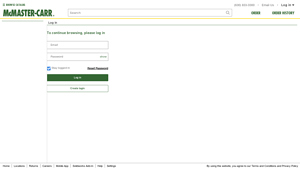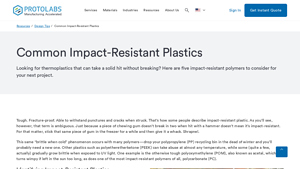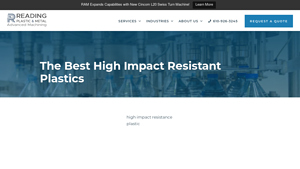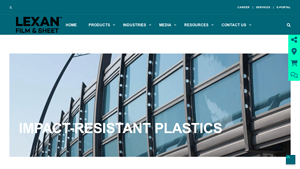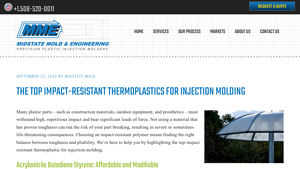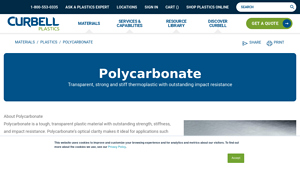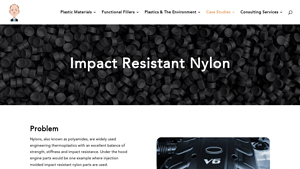Impact Resistant Plastic Guide: Type, Cost, Top List…
Introduction: Navigating the Global Market for impact resistant plastic
In the dynamic landscape of global manufacturing, sourcing impact-resistant plastic poses a significant challenge for international B2B buyers. This material’s ability to withstand high-impact forces without breaking or deforming is crucial for various applications, from automotive parts to consumer goods. Understanding the nuances of impact-resistant plastics—such as their types, specific applications, and performance metrics—can greatly influence the success of your projects.
This comprehensive guide aims to equip B2B buyers, particularly those from regions like Africa, South America, the Middle East, and Europe—including emerging markets such as Vietnam and Nigeria—with the insights needed to make informed purchasing decisions. We will delve into the leading types of impact-resistant plastics, such as Acrylonitrile Butadiene Styrene (ABS), High-Density Polyethylene (HDPE), and Polycarbonate (PC), discussing their unique properties and suitability for various applications.
Additionally, we will provide actionable strategies for vetting suppliers, understanding cost implications, and evaluating material performance based on industry-standard tests. By the end of this guide, you will be empowered to navigate the complexities of sourcing impact-resistant plastics, ensuring that you select materials that not only meet your technical requirements but also enhance your product’s durability and longevity in the market.
Understanding impact resistant plastic Types and Variations
| Type Name | Key Distinguishing Features | Primary B2B Applications | Brief Pros & Cons for Buyers |
|---|---|---|---|
| Acrylonitrile Butadiene Styrene (ABS) | High impact resistance, good machinability, cost-effective | Automotive parts, consumer goods, toys | Pros: Versatile, easy to work with; Cons: Not food-safe, lower heat resistance. |
| High-Density Polyethylene (HDPE) | Excellent toughness, chemical resistance, low-cost | Chemical tanks, outdoor equipment | Pros: Durable, easy to fabricate; Cons: Limited heat resistance, potential for stress cracking. |
| Polycarbonate (PC) | High transparency, excellent impact resistance | Safety goggles, architectural glazing | Pros: Strong, glass alternative; Cons: Expensive, prone to scratching. |
| Polyamide-imide (PAI) | Exceptional strength, thermal stability, chemical resistance | Semiconductor machinery, electrical connectors | Pros: High durability, maintains integrity under stress; Cons: Costly, difficult to process. |
| High Impact Polystyrene (HIPS) | Good impact and fatigue resistance, lightweight | Consumer goods, food storage components | Pros: Food-safe, easy to fabricate; Cons: Not eco-friendly, flammable. |
What are the Characteristics of Acrylonitrile Butadiene Styrene (ABS)?
ABS is a widely utilized impact-resistant plastic known for its balance between toughness and cost-effectiveness. Its ability to be easily machined and bonded makes it a favored choice in automotive and consumer product manufacturing. However, buyers should note that while ABS excels in impact resistance, it is not suitable for applications involving food and beverages due to safety regulations. When purchasing ABS, consider the manufacturing temperature, as it significantly influences the material’s final properties.
How Does High-Density Polyethylene (HDPE) Stand Out?
HDPE is recognized for its impressive toughness and chemical resistance, making it an ideal choice for various industrial applications. Its tightly packed molecular structure grants it rigidity and durability, especially in environments where exposure to chemicals is common. While HDPE is relatively low-cost and easy to fabricate, it has limitations in heat resistance and can suffer from stress cracking under extreme conditions. Buyers should evaluate the specific environmental factors their products will face when selecting HDPE.
Why Choose Polycarbonate (PC) for High-Impact Applications?
Polycarbonate is a high-performance plastic that combines exceptional impact resistance with optical clarity. This makes it a popular choice for safety equipment, such as goggles and helmets, as well as architectural applications requiring transparent materials. Despite its advantages, the higher cost and susceptibility to scratches may deter some buyers. When considering polycarbonate, it’s essential to assess the trade-offs between its durability and cost, especially in budget-sensitive projects.
What Makes Polyamide-imide (PAI) a Premium Option?
PAI is a high-performance thermoplastic that excels in demanding applications requiring both strength and thermal stability. Its remarkable resistance to chemicals and ability to maintain dimensional stability under high temperatures make it suitable for components in semiconductor machinery and electrical connectors. However, PAI’s processing challenges and higher cost can be limiting factors for some manufacturers. Buyers should weigh the performance benefits against the investment required when considering PAI for their projects.
What are the Benefits and Drawbacks of High Impact Polystyrene (HIPS)?
HIPS is characterized by its lightweight nature and good impact resistance, making it a practical choice for a variety of consumer products and food storage solutions. Its food-safe properties and ease of fabrication are significant advantages for businesses in the food industry. However, HIPS poses environmental challenges, as it is not biodegradable and has a long degradation period. Buyers should consider the environmental impact and regulatory requirements of HIPS in their product designs, particularly in markets increasingly focused on sustainability.
Key Industrial Applications of impact resistant plastic
| Industry/Sector | Specific Application of Impact Resistant Plastic | Value/Benefit for the Business | Key Sourcing Considerations for this Application |
|---|---|---|---|
| Automotive | Car Bumpers and Exterior Panels | Enhanced safety, durability, and aesthetics | Supplier certifications, material compliance, and cost |
| Construction | Protective Glazing for Buildings | Impact resistance and energy efficiency | UV resistance, thermal stability, and local sourcing |
| Consumer Electronics | Housing for Devices (e.g., smartphones) | Lightweight design and shock absorption | Design flexibility, compatibility with manufacturing processes |
| Medical Devices | Protective Casings for Equipment | Safety and sterility in healthcare settings | Regulatory compliance, biocompatibility, and durability |
| Packaging | Impact-Resistant Containers for Shipping | Reduces product damage and returns | Weight-to-strength ratio, recyclability, and cost-effectiveness |
How is Impact Resistant Plastic Used in the Automotive Industry?
In the automotive sector, impact resistant plastics such as ABS and polycarbonate are crucial for manufacturing car bumpers and exterior panels. These materials provide enhanced safety by absorbing impact energy during collisions, thereby protecting both passengers and the vehicle structure. For B2B buyers, sourcing these materials requires attention to certifications and compliance with safety standards, especially in regions like Africa and South America, where road conditions may vary significantly.
What Role Does Impact Resistant Plastic Play in Construction?
In construction, impact resistant plastics are often utilized for protective glazing in buildings, especially in areas prone to extreme weather conditions. These materials not only provide security against impacts but also enhance energy efficiency by allowing natural light while minimizing heat loss. Buyers in the Middle East and Europe should consider UV resistance and thermal stability when sourcing, ensuring that the materials can withstand local environmental conditions.
How is Impact Resistant Plastic Beneficial in Consumer Electronics?
Impact resistant plastics are widely used in the consumer electronics industry for device housings, such as smartphones and tablets. These materials offer lightweight designs while providing excellent shock absorption, essential for protecting delicate electronic components. International buyers should focus on the design flexibility and compatibility with existing manufacturing processes, particularly in regions like Vietnam and Nigeria, where local production capabilities may vary.
Why is Impact Resistant Plastic Important for Medical Devices?
In the medical device industry, impact resistant plastics are integral for protective casings around sensitive equipment. These materials ensure safety and sterility, which are critical in healthcare settings. B2B buyers must prioritize sourcing materials that meet regulatory compliance and biocompatibility standards, particularly in regions with stringent healthcare regulations.
How Does Impact Resistant Plastic Improve Packaging Solutions?
Impact resistant plastics are increasingly used in packaging, particularly for shipping containers that require durability against rough handling. These materials help reduce product damage during transit, significantly lowering return rates and enhancing customer satisfaction. Buyers should evaluate the weight-to-strength ratio and recyclability of the materials, ensuring cost-effectiveness while meeting sustainability goals in various international markets.
3 Common User Pain Points for ‘impact resistant plastic’ & Their Solutions
Scenario 1: Choosing the Right Impact-Resistant Plastic for Specific Applications
The Problem: B2B buyers often face challenges when selecting the appropriate type of impact-resistant plastic for their specific applications. With numerous options like ABS, HDPE, and polycarbonate available, it can be overwhelming to determine which material offers the best combination of impact resistance, cost, and suitability for the intended use. For instance, a manufacturer in the automotive industry may need a durable material for bumpers that can withstand both impact and environmental factors, yet they may not have the technical knowledge to evaluate all the material specifications.
The Solution: To effectively choose the right impact-resistant plastic, buyers should start by conducting a thorough application analysis. This includes understanding the environmental conditions the product will face—such as temperature fluctuations, UV exposure, and potential chemical interactions. Utilizing material data sheets and technical documentation from suppliers can provide crucial insights. Buyers should also consider conducting a comparative analysis using impact test results like Notched Izod or Gardner impact metrics. Engaging with suppliers who offer sample testing can further assist in making an informed decision. By establishing clear performance criteria based on the specific application, companies can streamline their selection process and enhance product durability.
Scenario 2: Cost Management and Material Waste in Production
The Problem: Another significant pain point for B2B buyers is managing costs associated with high-performance impact-resistant plastics, particularly when considering factors such as material waste during production. In regions like Africa and South America, where manufacturing budgets may be tighter, the expense of sourcing premium materials can strain resources. Additionally, improper material selection or machining can lead to increased scrap rates, further exacerbating costs.
The Solution: To mitigate these issues, buyers should adopt a two-pronged approach: optimizing material selection and refining manufacturing processes. First, evaluate the total cost of ownership for each material, which includes not just the upfront costs but also potential savings from reduced waste and longer service life. Consider investing in training for staff on best practices for machining and handling impact-resistant plastics to minimize errors and waste. Implementing a lean manufacturing approach can also help identify and eliminate inefficiencies in the production process. Collaborating with suppliers that offer design assistance can result in more efficient part geometries that reduce material usage while maintaining strength.
Scenario 3: Long-Term Performance and Environmental Considerations
The Problem: As sustainability becomes increasingly important, B2B buyers are often concerned about the long-term performance of impact-resistant plastics in relation to environmental impact. Many traditional plastics are not biodegradable and can contribute to pollution. Buyers in regions with stringent environmental regulations may struggle to find materials that meet both performance requirements and sustainability goals.
The Solution: To address these concerns, buyers should explore advanced formulations of impact-resistant plastics that offer improved environmental profiles, such as bio-based or recycled materials. Engaging with manufacturers who specialize in sustainable materials can provide options that align with corporate social responsibility goals. Additionally, conducting lifecycle assessments can help evaluate the environmental impact of different materials over their lifespan. Buyers should also consider designing products for disassembly and recycling, which can facilitate end-of-life solutions that minimize waste. By prioritizing sustainability in material selection, companies can enhance their brand reputation and comply with evolving regulations while still meeting performance standards.
Strategic Material Selection Guide for impact resistant plastic
What Are the Key Properties of Impact-Resistant Plastics?
When selecting impact-resistant plastics, it is essential to consider their key properties, which directly influence product performance. The temperature and pressure ratings are critical, as many plastics become brittle at lower temperatures. Corrosion resistance is also vital, especially in industries where exposure to harsh chemicals is common. Understanding these properties helps in determining the suitability of materials for specific applications.
How Do the Pros and Cons of Impact-Resistant Plastics Affect Manufacturing?
-
Acrylonitrile Butadiene Styrene (ABS)
– Key Properties: ABS exhibits excellent impact resistance and is versatile in temperature performance, with higher toughness at lower temperatures.
– Pros: It is easy to machine, bonds well with adhesives, and is moderately priced. ABS is widely used in automotive parts and consumer goods.
– Cons: It is not suitable for food applications and can be less durable under prolonged UV exposure.
– Impact on Application: ABS is ideal for products requiring a good balance of toughness and cost-effectiveness, but caution is needed in outdoor applications due to UV sensitivity.
– Considerations for International Buyers: Compliance with safety standards like ASTM is crucial, especially in markets with stringent regulations. -
Polycarbonate (PC)
– Key Properties: Known for its high impact resistance and transparency, PC performs well in various temperature ranges but is sensitive to scratching.
– Pros: Its clarity makes it a preferred choice for applications like protective eyewear and architectural glazing.
– Cons: The cost can be prohibitive for some applications, and it may not withstand harsh environmental conditions without protective coatings.
– Impact on Application: PC is suitable for high-impact environments but may require additional treatments for outdoor use to enhance scratch resistance.
– Considerations for International Buyers: Ensure compliance with local standards and consider the availability of protective coatings in specific regions. -
High-Density Polyethylene (HDPE)
– Key Properties: HDPE is characterized by its excellent tensile strength and impact resistance, along with good chemical resistance.
– Pros: It is cost-effective and easy to fabricate, making it popular in outdoor applications and chemical containers.
– Cons: It has limited heat resistance and can suffer from stress cracking under extreme conditions.
– Impact on Application: HDPE is ideal for outdoor applications but may not be suitable for high-temperature environments.
– Considerations for International Buyers: Buyers should be aware of local recycling capabilities, as HDPE is not eco-friendly and can be challenging to recycle. -
Polyamide-imide (PAI)
– Key Properties: PAI is known for its exceptional toughness, chemical resistance, and dimensional stability at high temperatures.
– Pros: It maintains performance under extreme conditions and is suitable for high-stress applications like bearings and valves.
– Cons: PAI is expensive and challenging to process, limiting its use to specialized applications.
– Impact on Application: PAI is ideal for high-performance components but may not be cost-effective for mass production.
– Considerations for International Buyers: Ensure that suppliers can meet the specific quality standards required for specialized applications.
Summary Table of Impact-Resistant Plastics
| Material | Typical Use Case for impact resistant plastic | Key Advantage | Key Disadvantage/Limitation | Relative Cost (Low/Med/High) |
|---|---|---|---|---|
| Acrylonitrile Butadiene Styrene (ABS) | Automotive parts, consumer goods | Good balance of toughness and cost | Not suitable for food applications | Medium |
| Polycarbonate (PC) | Protective eyewear, architectural glazing | High impact resistance and transparency | High cost and scratch sensitivity | High |
| High-Density Polyethylene (HDPE) | Outdoor furniture, chemical containers | Cost-effective and easy to fabricate | Limited heat resistance and stress cracking | Low |
| Polyamide-imide (PAI) | Bearings, valves, and high-performance components | Exceptional toughness and chemical resistance | Expensive and difficult to process | High |
In-depth Look: Manufacturing Processes and Quality Assurance for impact resistant plastic
What Are the Key Stages in the Manufacturing Process of Impact Resistant Plastics?
The manufacturing process for impact resistant plastics involves several critical stages, each designed to ensure the final product meets the required specifications for toughness and durability. Understanding these stages can help B2B buyers make informed decisions when sourcing impact resistant plastic components.
Material Preparation: How Are Raw Materials Processed for Impact Resistance?
The first step in the manufacturing process is the preparation of raw materials. This typically involves selecting high-quality plastic resins, such as Acrylonitrile Butadiene Styrene (ABS), Polycarbonate (PC), or High-Density Polyethylene (HDPE). The selected resin is then dried to remove moisture, which can adversely affect the properties of the final product.
Once dried, the resin is often blended with additives that enhance its impact resistance, UV stability, and processing characteristics. These additives can include impact modifiers, colorants, and stabilizers. The formulation of these blends is crucial, as the proportions can significantly affect the material’s toughness and performance under different conditions.
What Forming Techniques Are Commonly Used for Impact Resistant Plastics?
After material preparation, the next stage is forming the plastic into the desired shape. The primary techniques used for this purpose include:
-
Injection Molding: This is the most common method for producing complex shapes with high precision. The prepared plastic is heated until it melts and is then injected into a mold. The cooling process solidifies the plastic, creating a part that retains the desired properties. Injection molding is particularly advantageous for high-volume production.
-
Extrusion: For applications requiring long, continuous shapes (like pipes or sheets), extrusion is the preferred method. The plastic is pushed through a die, shaping it as it cools and solidifies.
-
Blow Molding: This technique is used for hollow parts. The molten plastic is inflated within a mold to create the desired hollow shape, commonly used in producing containers and bottles.
-
3D Printing: While not as common for high-volume production, additive manufacturing techniques are gaining traction for prototyping and small-batch production of complex geometries, allowing for rapid iteration and customization.
How Is Assembly Handled in the Production of Impact Resistant Plastics?
In many applications, components made from impact resistant plastics require assembly with other parts. This can involve mechanical fastening, adhesive bonding, or thermal welding. The assembly process must ensure that the integrity of the impact resistance is maintained, which may require specific techniques such as using adhesives compatible with the plastic’s surface chemistry.
What Finishing Processes Enhance the Performance of Impact Resistant Plastics?
Finishing processes are essential for enhancing the aesthetic appeal and functional characteristics of impact resistant plastic components. Common finishing techniques include:
- Surface Treatment: Processes such as sanding, polishing, or coating can improve the surface finish and increase resistance to scratches and UV degradation.
- Painting and Coating: Applying protective coatings or paints can enhance chemical resistance and provide additional UV protection, which is crucial for outdoor applications.
- Quality Control Checks: Each stage of manufacturing incorporates quality control measures to ensure that the components meet specified standards before moving to the next stage.
What Quality Assurance Standards Are Relevant for Impact Resistant Plastics?
Quality assurance is crucial in ensuring that impact resistant plastics meet international and industry-specific standards. For B2B buyers, understanding these standards can provide confidence in the materials sourced from suppliers.
Which International Standards Should Buyers Be Aware Of?
- ISO 9001: This standard focuses on quality management systems and is applicable to organizations that need to demonstrate their ability to consistently provide products that meet customer and regulatory requirements.
- ISO 14001: For companies concerned with environmental management, ISO 14001 provides guidelines for efficient resource use and waste reduction.
- ASTM and ISO Testing Standards: Various ASTM (American Society for Testing and Materials) and ISO standards define testing methods for impact resistance, such as the Notched IZOD and Charpy impact tests. These methods are vital for comparing the toughness of different materials.
What Are the Key Quality Control Checkpoints in Manufacturing?
Quality control during the manufacturing of impact resistant plastics typically involves several checkpoints:
-
Incoming Quality Control (IQC): This initial stage checks the quality of raw materials before they enter the production process. Testing for moisture content and verifying material specifications are common practices.
-
In-Process Quality Control (IPQC): During manufacturing, regular checks are performed to ensure that the processes remain within specified limits. This includes monitoring temperature, pressure, and cycle times during injection molding or extrusion.
-
Final Quality Control (FQC): After production, the finished products undergo rigorous testing to ensure they meet the required specifications. This may include physical inspections, performance testing, and compliance verification against international standards.
How Can B2B Buyers Verify Supplier Quality Control Practices?
To ensure that the suppliers of impact resistant plastics adhere to quality control practices, B2B buyers should consider the following approaches:
-
Supplier Audits: Conducting regular audits of suppliers can provide insights into their quality management practices. This includes reviewing their quality control processes, documentation, and compliance with international standards.
-
Requesting Quality Reports: Buyers should ask for detailed quality reports that outline testing results, material specifications, and certifications. This documentation can help in assessing the reliability of the supplier.
-
Third-Party Inspections: Engaging third-party inspection services can provide an unbiased evaluation of the manufacturing processes and quality control measures in place at the supplier’s facility.
What Are the Challenges in Quality Control for International Buyers?
For international buyers, particularly those from Africa, South America, the Middle East, and Europe, navigating the quality control landscape can present unique challenges:
-
Cultural Differences: Variations in manufacturing standards and practices can lead to discrepancies in quality expectations. Buyers must ensure that they communicate their requirements clearly.
-
Logistical Issues: Transportation and customs can introduce risks of damage or degradation of materials, making it essential to work with suppliers who have robust packaging and shipping processes.
-
Regulatory Compliance: Understanding local regulations regarding material safety, environmental impact, and product standards is crucial for compliance and market entry.
By being informed about the manufacturing processes and quality assurance standards specific to impact resistant plastics, B2B buyers can make better sourcing decisions that align with their operational needs and market demands.
Practical Sourcing Guide: A Step-by-Step Checklist for ‘impact resistant plastic’
This guide is designed to assist B2B buyers in the effective procurement of impact-resistant plastics. By following these steps, you can ensure that the materials you source meet the necessary technical specifications and performance requirements for your applications.
Step 1: Define Your Technical Specifications
Start by outlining the specific requirements for your project, including impact resistance, temperature tolerance, and chemical exposure. Identifying these parameters will help you narrow down the most suitable types of impact-resistant plastics, such as ABS, HDPE, or polycarbonate. It’s essential to consider the environment in which the material will be used, as this can significantly influence its performance.
Step 2: Research Available Materials
Familiarize yourself with the different types of impact-resistant plastics available in the market. Each material has unique properties; for instance, while polycarbonate offers excellent transparency and toughness, it may not be cost-effective for all applications. Additionally, evaluate the Notched IZOD impact test values provided by manufacturers to assess each material’s resistance to breakage under stress.
Step 3: Evaluate Potential Suppliers
Before committing to a supplier, conduct a thorough evaluation. Request detailed company profiles, case studies, and references from clients in similar industries or regions. This step is crucial to ensure that the supplier has a proven track record of delivering quality products and can meet your specific needs reliably.
Step 4: Verify Supplier Certifications
Ensure that your chosen suppliers comply with relevant international standards and certifications, such as ISO and ASTM. This verification is vital for confirming the quality and safety of the impact-resistant plastics you intend to procure. Look for certifications that demonstrate adherence to material testing and quality control processes.
Step 5: Request Samples for Testing
Before making a bulk purchase, always request samples of the materials you are considering. Conduct your own testing to assess how the plastics perform under conditions similar to those they will face in real-world applications. This practical evaluation will provide insights into the material’s durability and suitability for your specific use case.
Step 6: Negotiate Terms and Conditions
Once you have identified a suitable supplier and material, negotiate the terms of your purchase. Discuss pricing, lead times, minimum order quantities, and delivery schedules. Clear communication regarding these aspects will help avoid misunderstandings and ensure a smooth transaction process.
Step 7: Plan for Long-Term Collaboration
Consider establishing a long-term partnership with your supplier. A reliable supplier can provide ongoing support, updates on new materials, and assistance with technical issues. Building this relationship can lead to better pricing, priority service, and access to innovations in impact-resistant plastics as your needs evolve.
By following this checklist, B2B buyers can make informed decisions and secure high-quality impact-resistant plastics that meet their operational demands.
Comprehensive Cost and Pricing Analysis for impact resistant plastic Sourcing
What Are the Key Cost Components for Sourcing Impact Resistant Plastics?
When sourcing impact resistant plastics, understanding the cost structure is crucial for making informed purchasing decisions. The primary cost components include:
-
Materials: The choice of plastic significantly impacts costs. For instance, high-performance plastics like polycarbonate or polyamide-imide are typically more expensive than materials like ABS or HDPE. Pricing can also fluctuate based on global resin market conditions.
-
Labor: Labor costs can vary by region and the complexity of the manufacturing processes. Skilled labor may be required for high-precision applications, thereby increasing costs. In regions with lower wage standards, labor costs can be more economical.
-
Manufacturing Overhead: This encompasses operational costs such as utilities, maintenance, and administrative expenses. Facilities with advanced technologies may incur higher overhead costs but can also enhance production efficiency.
-
Tooling: Initial tooling costs can be substantial, especially for custom molds or specific manufacturing processes. Understanding the tooling lifespan and amortizing these costs over production volume is essential for pricing.
-
Quality Control (QC): Ensuring that impact resistant plastics meet specified standards is vital. This may involve additional testing and certification processes, adding to the overall cost.
-
Logistics: Transportation and shipping costs are significant, particularly for international buyers. Factors such as distance, shipping method, and the need for specialized handling can influence logistics expenses.
-
Margin: Suppliers typically include a profit margin in their pricing, which can vary based on competition, market demand, and the perceived value of the product.
How Do Price Influencers Affect the Cost of Impact Resistant Plastics?
Several factors can influence the pricing of impact resistant plastics:
-
Volume/MOQ: Purchasing in larger quantities often leads to lower per-unit costs. Suppliers may offer discounts for minimum order quantities (MOQs), incentivizing bulk purchases.
-
Specifications and Customization: Customized products tailored to specific applications can increase costs. Buyers should clearly define their requirements to avoid unexpected expenses.
-
Material Quality and Certifications: Higher-quality materials or those that meet specific industry certifications (e.g., ISO, ASTM) generally command higher prices. It is essential to balance the need for quality against budget constraints.
-
Supplier Factors: The reputation and reliability of the supplier can also influence pricing. Established suppliers with a proven track record may charge a premium for their products.
-
Incoterms: Understanding Incoterms (International Commercial Terms) is critical for determining who bears the cost and risk during shipping. Different terms can significantly affect overall costs.
What Tips Can Buyers Use to Negotiate Better Pricing for Impact Resistant Plastics?
Negotiating effectively can lead to more favorable pricing:
-
Research and Compare: Gather quotes from multiple suppliers and compare their offerings. Understanding market prices helps in negotiating better deals.
-
Total Cost of Ownership (TCO): Consider the TCO, which includes purchase price, maintenance, and operational costs. A lower upfront cost might lead to higher long-term expenses.
-
Build Relationships: Establishing strong relationships with suppliers can lead to better pricing and terms. Long-term partnerships may result in loyalty discounts or priority service.
-
Be Transparent About Needs: Clearly communicate your requirements and constraints. This fosters trust and can help suppliers provide tailored solutions that meet your needs without unnecessary costs.
What Pricing Nuances Should International Buyers Consider?
International buyers, particularly from Africa, South America, the Middle East, and Europe, should be aware of several pricing nuances:
-
Currency Fluctuations: Exchange rates can impact costs. It’s advisable to agree on a currency for transactions to mitigate risks associated with fluctuations.
-
Import Duties and Taxes: Understand local regulations regarding import duties, VAT, and other taxes. These can add significantly to the total cost.
-
Cultural Considerations: Different regions may have varying expectations around negotiations and pricing. Familiarize yourself with local business practices to enhance communication and build rapport.
Disclaimer on Indicative Prices
Pricing for impact resistant plastics can vary widely based on the aforementioned factors. It is advisable to seek current quotes from suppliers to obtain accurate pricing tailored to specific needs and circumstances.
Alternatives Analysis: Comparing impact resistant plastic With Other Solutions
Exploring Alternatives to Impact Resistant Plastic
When evaluating materials for products that require durability and resilience against high-impact forces, it’s essential to consider a range of alternatives to impact-resistant plastic. Each option has its unique advantages and potential drawbacks, making it crucial for B2B buyers to understand how these materials compare in terms of performance, cost, and application.
Comparison Table
| Comparison Aspect | Impact Resistant Plastic | Metal Alloys | Glass Fiber Reinforced Polymer (GFRP) |
|---|---|---|---|
| Performance | High impact resistance; versatile across temperatures | Excellent strength; can be heavy | High strength-to-weight ratio; good impact resistance |
| Cost | Moderate cost; varies by type | Generally higher cost; requires machining | Moderate cost; cost-effective in large quantities |
| Ease of Implementation | Easy to mold and shape; suitable for mass production | Requires specialized fabrication | Requires careful handling and expertise for molding |
| Maintenance | Low maintenance; resistant to corrosion | Moderate; may require coatings for corrosion resistance | Low maintenance; resistant to many chemicals |
| Best Use Case | Automotive parts, consumer electronics, toys | Structural components, aerospace, automotive | Sporting goods, automotive, construction applications |
Detailed Breakdown of Alternatives
Metal Alloys
Metal alloys, such as aluminum and steel, offer exceptional strength and durability. They are often used in applications that require high structural integrity, such as in aerospace and automotive industries. However, metal alloys can be heavier than plastics, which may not be suitable for all applications. Additionally, they typically require more complex manufacturing processes, leading to higher costs and longer lead times. Corrosion resistance can also be a concern, necessitating protective coatings in some environments.
Glass Fiber Reinforced Polymer (GFRP)
GFRP is a composite material that combines glass fibers with a polymer matrix, resulting in a lightweight yet strong product. Its high strength-to-weight ratio makes it an excellent alternative for applications where weight savings are crucial, such as in automotive and sporting goods. GFRP can also withstand significant impacts and is resistant to many environmental factors. However, the manufacturing process can be more complicated, requiring specialized knowledge and equipment. Additionally, the initial costs can be moderate, but they may become cost-effective at larger production scales.
Conclusion: How Should B2B Buyers Choose the Right Solution?
When selecting the right material for a project, B2B buyers should carefully assess their specific requirements, including performance expectations, budget constraints, and manufacturing capabilities. Impact-resistant plastics are often the go-to choice for many applications due to their versatility and cost-effectiveness. However, in cases where strength and weight are critical, metal alloys or GFRP may provide superior performance. By understanding the unique attributes and limitations of each alternative, buyers can make informed decisions that align with their operational needs and product objectives.
Essential Technical Properties and Trade Terminology for impact resistant plastic
What Are the Key Technical Properties of Impact Resistant Plastics?
When selecting impact-resistant plastics for industrial applications, understanding their technical properties is crucial for ensuring product reliability and longevity. Here are some critical specifications to consider:
-
Notched Izod Impact Strength
This metric measures the energy absorbed by a plastic material when subjected to a sudden impact. It is expressed in joules per square meter (j/m²) and is vital for determining how well a plastic can withstand shocks. For example, a material with a Notched Izod score of 200 j/m² or higher is considered suitable for demanding applications. This property helps manufacturers assess the material’s performance under real-world conditions, reducing the risk of part failure. -
Material Grade
Material grade refers to the specific formulation of a plastic that dictates its mechanical properties, thermal stability, and chemical resistance. Different grades of the same plastic type, such as ABS or polycarbonate, can exhibit varying degrees of impact resistance and other characteristics. Selecting the appropriate material grade is essential for meeting the specific requirements of an application, thereby ensuring compatibility and performance. -
Tensile Strength
This property indicates how much force a material can withstand while being stretched or pulled before breaking. Measured in megapascals (MPa), tensile strength is crucial for applications where materials experience tension. Higher tensile strength often correlates with better impact resistance, making it a critical factor in the selection process for load-bearing components. -
Thermal Stability
Thermal stability refers to a material’s ability to maintain its properties at elevated temperatures. This is particularly important for impact-resistant plastics, as prolonged exposure to high heat can lead to degradation and loss of toughness. Understanding a material’s thermal stability helps manufacturers design components that perform reliably in various environmental conditions. -
Elongation at Break
This property measures the extent to which a plastic can be stretched before it fractures, expressed as a percentage. A higher elongation at break indicates greater ductility, allowing the material to absorb energy without breaking. This characteristic is vital in applications where flexibility and impact absorption are required, as it helps to prevent catastrophic failures.
What Are Common Trade Terms Related to Impact Resistant Plastics?
Navigating the landscape of impact-resistant plastics also requires familiarity with specific trade terminology. Here are several key terms that are important for B2B transactions:
-
OEM (Original Equipment Manufacturer)
An OEM produces parts that are used in another company’s end products. Understanding OEM relationships is critical for businesses looking to source impact-resistant plastics as components in their own manufacturing processes. This ensures compatibility and quality standards are met. -
MOQ (Minimum Order Quantity)
MOQ refers to the minimum number of units a supplier is willing to sell in a single order. This term is essential for B2B buyers to know, as it can affect inventory management and pricing strategies. Understanding MOQs can help companies optimize their procurement processes and negotiate better terms. -
RFQ (Request for Quotation)
An RFQ is a formal document sent to suppliers requesting pricing and terms for specific products or services. It is a critical step in the procurement process, allowing businesses to compare offers from multiple suppliers for impact-resistant plastics, ensuring they receive competitive pricing and terms. -
Incoterms (International Commercial Terms)
Incoterms are a set of predefined commercial terms used in international trade that define the responsibilities of buyers and sellers regarding shipping, insurance, and tariffs. Familiarity with Incoterms is essential for B2B buyers, as it helps clarify who is responsible for various costs and risks during the shipping process of impact-resistant plastics. -
Lead Time
Lead time is the amount of time taken from the initiation of an order to its completion. For impact-resistant plastics, understanding lead times is essential for project planning and ensuring that materials arrive on schedule to meet production deadlines.
By grasping these key technical properties and trade terms, B2B buyers can make informed decisions when selecting impact-resistant plastics, ultimately enhancing product performance and supply chain efficiency.
Navigating Market Dynamics and Sourcing Trends in the impact resistant plastic Sector
What Are the Current Market Dynamics and Key Trends in the Impact Resistant Plastic Sector?
The impact resistant plastic market is experiencing significant growth driven by several global factors. The increasing demand for durable materials across industries such as automotive, construction, and consumer goods is a primary catalyst. As companies seek to enhance product longevity and reduce replacement costs, the focus on tough and resilient materials is intensifying. Furthermore, advancements in manufacturing technologies, such as 3D printing and CNC machining, are enabling innovative applications and design flexibility, which appeal to international B2B buyers.
Emerging trends include a shift towards high-performance materials like polycarbonate and polyamide-imide, which offer superior impact resistance and thermal stability. Buyers from regions such as Africa, South America, the Middle East, and Europe are particularly interested in sourcing these materials due to their robustness and adaptability in diverse climatic conditions. Additionally, the rise of smart manufacturing technologies is fostering greater efficiency in supply chains, allowing buyers to track material performance and sustainability metrics in real-time.
As the market evolves, understanding local regulations and compliance standards is crucial for international buyers. Countries are increasingly enforcing stringent safety and quality requirements for materials used in various applications, making it imperative for businesses to stay informed about the specific regulations that affect their sourcing decisions.
How Does Sustainability and Ethical Sourcing Influence the Impact Resistant Plastic Market?
Sustainability is becoming a cornerstone of sourcing strategies in the impact resistant plastic sector. Buyers are increasingly aware of the environmental impact of their material choices, prompting a shift towards sustainable practices. Ethically sourced materials not only reduce ecological footprints but also enhance brand reputation and consumer trust. For businesses, aligning with suppliers that prioritize sustainability can lead to long-term cost savings and improved operational efficiencies.
The importance of ethical supply chains is underscored by the rising demand for ‘green’ certifications and materials. Certifications such as ISO 14001 for environmental management and the use of recycled content in products are gaining traction among international buyers. These certifications not only demonstrate a commitment to sustainability but also provide a competitive edge in a crowded marketplace.
Furthermore, innovations in bioplastics and recyclable polymers are emerging as viable alternatives to traditional impact resistant plastics. This transition towards sustainable materials not only addresses environmental concerns but also caters to a growing consumer base that prioritizes eco-friendly products. As a result, B2B buyers are encouraged to evaluate potential suppliers based on their sustainability practices and certifications, ensuring that their sourcing strategies align with global sustainability goals.
What Is the Evolution of Impact Resistant Plastics and Its Relevance to Today’s B2B Buyers?
The evolution of impact resistant plastics can be traced back to the early 20th century, with the development of materials like Bakelite and polycarbonate. These early innovations set the stage for the modern impact resistant plastics we see today, which are characterized by enhanced toughness and resilience. Over the decades, advancements in polymer science and manufacturing processes have led to the creation of a diverse range of materials, each with unique properties suited for specific applications.
Today, B2B buyers benefit from a wealth of options, from acrylonitrile butadiene styrene (ABS) to high-density polyethylene (HDPE), each offering distinct advantages in terms of impact resistance, cost, and manufacturability. The historical context of these materials underscores the importance of understanding their properties and applications, enabling buyers to make informed decisions that align with their operational needs and market demands.
In summary, the impact resistant plastic sector is not only growing but also transforming in response to market demands for sustainability and innovation. As B2B buyers navigate this dynamic landscape, staying informed about sourcing trends and material advancements will be critical for maintaining a competitive edge.
Frequently Asked Questions (FAQs) for B2B Buyers of impact resistant plastic
-
1. How do I choose the right impact-resistant plastic for my application?
Choosing the right impact-resistant plastic involves assessing the specific requirements of your application, such as temperature range, chemical exposure, and mechanical stresses. Start by reviewing the material properties of various plastics, like Acrylonitrile Butadiene Styrene (ABS), Polycarbonate (PC), and High-Density Polyethylene (HDPE). Evaluate their impact resistance metrics, such as Notched IZOD values, to ensure they meet your needs. Additionally, consider factors like ease of fabrication and cost, and consult with suppliers to obtain samples for testing in your environment. -
2. What is the best impact-resistant plastic for outdoor applications?
For outdoor applications, Polycarbonate (PC) is often the best choice due to its high impact resistance and UV stability. It provides transparency similar to glass, making it suitable for applications like protective shields and architectural glazing. However, if weight and cost are considerations, High-Density Polyethylene (HDPE) is also a viable option, offering excellent toughness and resistance to chemicals and corrosion. Evaluate your specific requirements and consult with suppliers for recommendations tailored to your project. -
3. What are the minimum order quantities (MOQs) for impact-resistant plastics?
Minimum order quantities (MOQs) for impact-resistant plastics can vary significantly by supplier and material type. Generally, MOQs may range from 100 kg to several tons, depending on the specific plastic and supplier capabilities. To find the best fit for your needs, discuss your project requirements with potential suppliers and inquire about their production capabilities. Many suppliers may offer flexibility for smaller orders, especially for custom formulations or prototypes. -
4. How do I ensure the quality of impact-resistant plastic materials?
To ensure quality, request certifications and material data sheets from suppliers, which should include impact resistance test results and compliance with international standards. Conduct thorough supplier vetting by checking their reputation, production processes, and quality control measures. Consider visiting manufacturing facilities or requesting samples for testing in your application. Establish clear quality assurance agreements that outline expectations for material performance and testing protocols. -
5. What payment terms should I expect when sourcing impact-resistant plastics internationally?
Payment terms can vary widely based on supplier policies and the nature of the transaction. Common terms include advance payments, letters of credit, or payment upon delivery. It is advisable to negotiate favorable terms that align with your cash flow needs and risk tolerance. Ensure that all payment terms are clearly documented in the purchase agreement to avoid misunderstandings. Additionally, consider using escrow services for large transactions to enhance security. -
6. How can I customize impact-resistant plastic products to fit my needs?
Customization options for impact-resistant plastic products typically include variations in color, thickness, and formulations to enhance specific properties. Collaborate closely with your supplier during the design phase to discuss your requirements and available options. Many manufacturers offer design assistance and prototyping services, allowing you to test modifications before full-scale production. Be prepared to provide detailed specifications and performance criteria to ensure the final product meets your expectations. -
7. What logistics considerations should I keep in mind when importing impact-resistant plastics?
When importing impact-resistant plastics, consider logistics factors such as shipping methods, lead times, and customs regulations. Choose a reliable freight forwarder experienced in handling plastics to navigate international shipping complexities. Ensure compliance with local import regulations, including tariffs and documentation requirements. Additionally, factor in potential delays due to customs clearance and plan your inventory management accordingly to avoid production interruptions. -
8. How do I assess the reliability of a supplier for impact-resistant plastics?
Assessing a supplier’s reliability involves researching their history, market reputation, and customer reviews. Request references from past clients and verify their experience with similar projects. Evaluate their production capabilities, quality control processes, and certifications to ensure they meet industry standards. Additionally, consider visiting their facility if possible, or request product samples for evaluation. Establishing strong communication and transparency from the outset can also indicate a supplier’s reliability and commitment to your needs.
Important Disclaimer & Terms of Use
⚠️ Important Disclaimer
The information provided in this guide, including content regarding manufacturers, technical specifications, and market analysis, is for informational and educational purposes only. It does not constitute professional procurement advice, financial advice, or legal advice.
While we have made every effort to ensure the accuracy and timeliness of the information, we are not responsible for any errors, omissions, or outdated information. Market conditions, company details, and technical standards are subject to change.
B2B buyers must conduct their own independent and thorough due diligence before making any purchasing decisions. This includes contacting suppliers directly, verifying certifications, requesting samples, and seeking professional consultation. The risk of relying on any information in this guide is borne solely by the reader.
Top 8 Impact Resistant Plastic Manufacturers & Suppliers List
1. Sybridge – Acrylonitrile Butadiene Styrene (ABS)
Domain: sybridge.com
Registered: 2003 (22 years)
Introduction: {‘Acrylonitrile Butadiene Styrene (ABS)’: {‘impact_resistance’: ‘high’, ‘cost’: ‘mid-range’, ‘applications’: [‘instrument panels’, ‘luggage’, ‘automotive parts’, ‘power tool housings’, “children’s toys”], ‘Notched_IZOD_metrics’: {‘min_value’: 200.0, ‘max_value’: 215.0}, ‘food_safe’: False}, ‘High-Density Polyethylene (HDPE)’: {‘impact_resistance’: ‘fantastic’, ‘tensile_strength’: ‘high’, ‘applicat…
2. McMaster – Impact-Resistant Plastics
Domain: mcmaster.com
Registered: 1994 (31 years)
Introduction: This company, McMaster – Impact-Resistant Plastics, is a notable entity in the market. For specific product details, it is recommended to visit their website directly.
3. Protolabs – Impact-Resistant Plastics
Domain: protolabs.com
Registered: 2006 (19 years)
Introduction: Common impact-resistant plastics include polyetheretherketone (PEEK) and polycarbonate (PC). Impact resistance is evaluated using tests such as Notched Izod Impact, Gardner Impact, and Instrumented Dart Impact, defined under ASTM and ISO standards. The performance of these materials can vary based on environmental factors like temperature and UV exposure.
4. Reading Plastic – High Impact Resistant Plastics
Domain: readingplastic.com
Registered: 1998 (27 years)
Introduction: Top 4 High Impact Resistant Plastics: 1. ABS (Acrylonitrile Butadiene Styrene): – Widely used thermoplastic – Applications: toy building blocks, automotive parts, instrument panels – Properties: outstanding impact resistance, lightweight, easy to machine, low cost, good strength and stiffness, easy to paint and bond, resistant to chemical corrosion. 2. Polycarbonate: – Known for transparency, can …
5. LEXAN™ – Impact-Resistant Polycarbonate Sheets
Domain: film-sheet-products.com
Registered: 2024 (1 years)
Introduction: LEXAN™ Impact-Resistant Plastics are high optical quality, virtually unbreakable polycarbonate sheets. They offer high impact strength, lightweight, spall protection, and coating ability for safety and security glazing. LEXAN sheets meet strict standards for specks, bubbles, distortion, and ripple. They are suitable for bulletproof laminates, anti-burglary, and anti-vandal glazing, helping to prot…
6. Midstate Mold – Acrylonitrile Butadiene Styrene (ABS)
Domain: midstatemold.com
Registered: 1997 (28 years)
Introduction: Acrylonitrile Butadiene Styrene (ABS): High impact resistance, mid-range cost, suitable for injection molding, bonds well with adhesives, modifiable properties with temperature (low temp for impact resistance, high temp for heat resistance), used in automotive parts, children’s toys, power tools, not suitable for food and beverages. Polycarbonate (PC): Tough, great manufacturability, transparent, …
7. Curbell Plastics – Polycarbonate Solutions
Domain: curbellplastics.com
Registered: 2000 (25 years)
Introduction: Polycarbonate is a tough, transparent thermoplastic with outstanding strength, stiffness, and impact resistance. It is ideal for applications such as machine guards, signs, architectural glazing, face shields, skylights, and POP displays.
**Applications:**
– Indoor and outdoor signs
– Architectural glazing
– POP displays and graphic holders
– Skylights
– Face shields
– Machine guards
– Se…
8. Phantom Plastics – Impact Resistant Nylon
Domain: phantomplastics.com
Registered: 2009 (16 years)
Introduction: Impact Resistant Nylon is a type of engineering thermoplastic known for its excellent balance of strength, stiffness, and impact resistance. It is commonly used in applications such as under-the-hood engine parts. The product aims to enhance impact resistance through the addition of specific additives, even at low concentrations. A notable case involved a major nylon manufacturer seeking innovativ…
Strategic Sourcing Conclusion and Outlook for impact resistant plastic
Why Is Strategic Sourcing Essential for Impact Resistant Plastics?
In the competitive landscape of international manufacturing, understanding the diverse range of impact-resistant plastics is crucial for optimizing product performance and longevity. From Acrylonitrile Butadiene Styrene (ABS) to Polyamide-imide (PAI), each material offers unique advantages that can cater to specific industrial needs. Strategic sourcing allows businesses to align their material choices with operational goals, ensuring that they select the right plastics to enhance durability, reduce failure rates, and ultimately lower costs.
How Can International Buyers Leverage Impact Resistant Plastics?
For buyers in regions like Africa, South America, the Middle East, and Europe, prioritizing impact-resistant plastics is not just about selecting a material; it’s about forging partnerships with reliable suppliers who understand local market dynamics and can provide tailored solutions. This approach will empower companies to innovate, meet regulatory standards, and enhance their competitive edge.
What Is the Future Outlook for Impact Resistant Plastics?
As global demand for durable materials continues to rise, the outlook for impact-resistant plastics remains strong. Buyers should actively seek out suppliers who are committed to sustainability and innovation, ensuring that their sourcing strategies are future-proof. Embrace this opportunity to enhance your product offerings and drive growth by investing in impact-resistant plastics today. Your next strategic move could redefine your market position and expand your business horizons.



